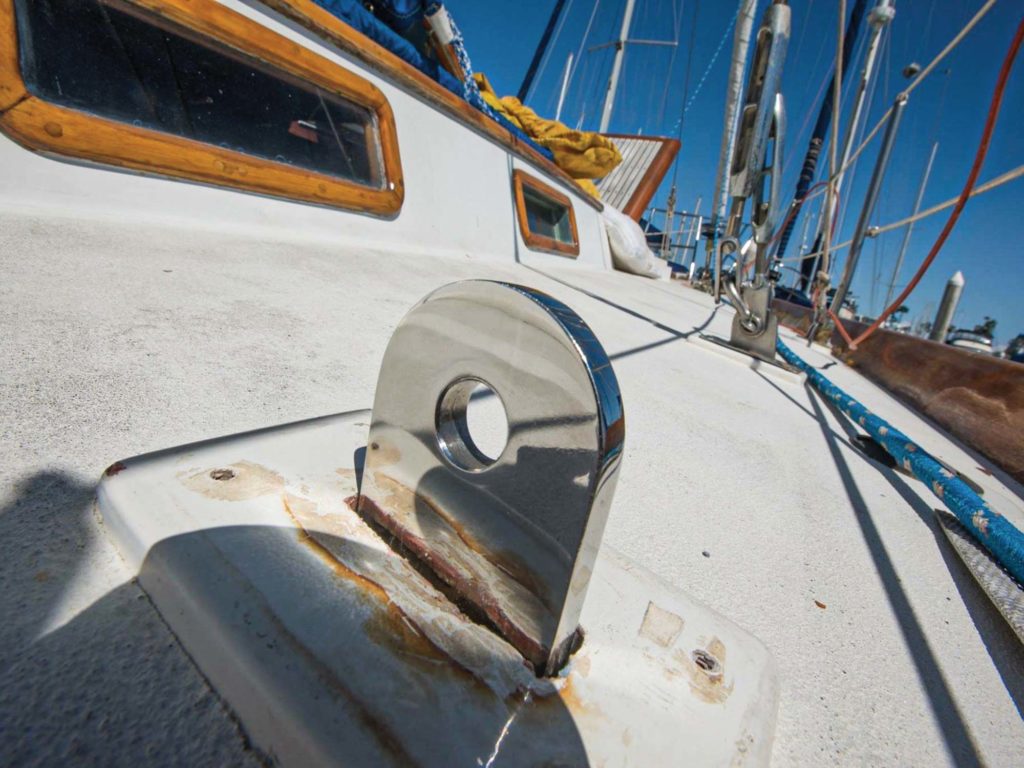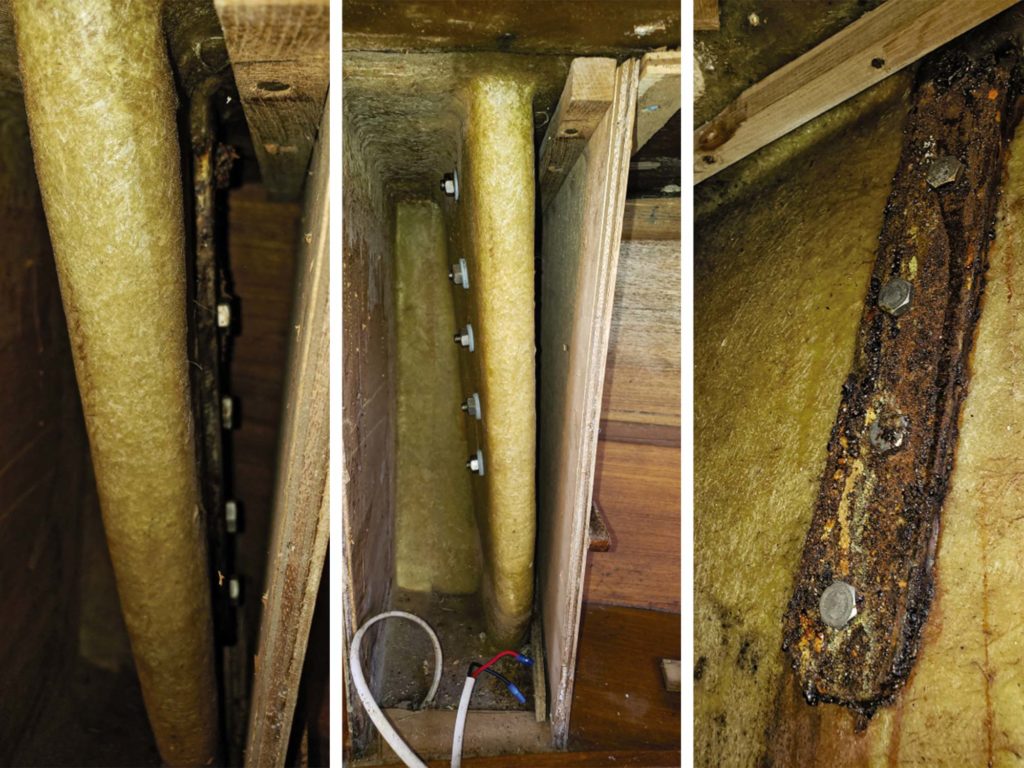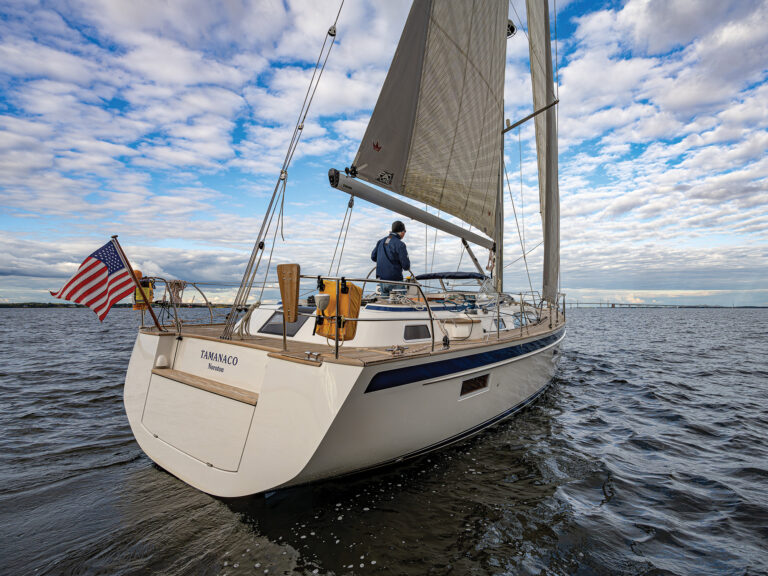
Dismasting is a worst-case scenario, and it can happen to any sailor in certain circumstances. The source of the failure is usually the chainplates, or lack thereof. A chainplate is a metal plate used to fasten a shroud or stay to the hull of a sailboat. One end of the chainplate is often fastened to a turnbuckle, which is then connected to the shroud or stay, while the remainder of the chainplate is normally through-bolted into the hull or bulkhead. Chainplates are commonly painted over, glassed into the hull, or out of reach in general, which unfortunately makes them out of sight, out of mind.
In typical installations, chainplates are hidden belowdecks in a locker—and this was the case with the shroud chainplates aboard our 1979 41-foot Cheoy Lee Avocet. Like many shipyards in that era, Cheoy Lee had a few ways they built and installed their chainplates. Some of their older Clippers and Luders models sported external chainplates, which are about as robust and easy to maintain as it gets, but in the ’70s and ’80s, the builder began moving the chainplates closer to the mast. This allowed better sheeting angles for the headsails.
In this configuration, the chainplates go through the deck and down into the cabin, where they attach to a bulkhead or a fiberglass knee. On Avocet,there are six substantial, dedicated knees for every midship chainplate, and one aft for the backstay. The chainplates for the shrouds are hidden behind cabinetry.
We sailed and worked on other projects that seemed more pressing until we found the time to open up our interior to inspect the chainplates. We were shocked: Our chainplates were completely rusted through, hanging on by less than a thread. With horror, we thought about how many times we had gone aloft to repair something, and about the gales we had sailed through—all while putting stress on a very compromised rig.
As what was left of our chainplates crumbled in our hands, we began the process of fabricating new, stronger chainplates, and of taking our close brush with disaster as a warning to be shared with sailors everywhere.
Ross Hubbard, a Southern California member of the Society of Accredited Marine Surveyors who has become a good friend of the Avocet crew, told us that he had seen similar situations—and worse.
“I think that on average, I see eight or so vessels with known chainplate failures a year,” he said. “After removing the plates, I’d say at least 60 percent have some type of plate problem such as pitting, cracks, fractures, etc. Unfortunately, the nature of the materials and installation methods almost guarantees failures.”

That assessment rings true for Avocet, which was built in Hong Kong—a place that was known for excellent fiberglass layups and poor metal compositions.
A thorough survey can protect you from buying a boat that is on the brink of rig failure, but what about those good ol’ boats that have been under the same ownership for a while? Experts say that any boat older than 20 years should have the chainplates rigorously inspected or replaced, along with the standing rigging in general.
“If there is any evidence of water leaking above and/or below deck (rivulets, rust staining, wood damage, veneer, varnish or paint failure/peeling on bulkheads where the plates are mounted) the plates should be removed,” Hubbard said. “If the boat is older, I suggest completely removing the plates for inspection rather than just observing them. The inspection should be conducted using at least 20-times magnification, as well as using a dye penetration system after an in-depth cleaning.”
Of course, this process will confirm only whether your chainplates need to be replaced. If that is the case, then you should get a professional rigging expert to assist in the replacement and installation.
Kim Weir, also in Southern California and a dear friend of ours, has been rigging there and in his native Australia since the 1980s. When we showed Weir the photos of our corroded chainplates, he was shocked but not necessarily surprised.
“I would say that 90 percent of the chainplates I inspect need to be replaced, and most of them are compromised by water intrusion,” he said.
Our boat had her fair share of leaks around the hull-to-deck joint and chainplate bases, resulting in some water damage belowdecks and the further deterioration of the original stainless chainplates. Back in the ’70s, Cheoy Lee used stainless bolts and bronze nuts to fasten the chainplates, a combination that led to dissimilar metal corrosion with the addition of salt water. Although our chainplates looked Bristol on the topsides, what was hiding underneath was an absolute nightmare.
“Just because the tops look fine and the rest is hidden doesn’t mean problems don’t exist,” Weir said. “Honestly, the harder they are to inspect is all the more reason to be suspicious as far as the status of their structural integrity goes.”
Determined to build better, we contacted a friend who is a skilled metalworker. We started by removing the two cap shrouds and backstay, leaving the four lowers to help stabilize the rig in addition to the halyards we ran as extra support. These first three plates were in the best condition of them all but had hairline cracks right where the plates intersected the deck. We knew that we would have to make a copy of each individual plate because they were not identical. That’s what a metalworker can do.
We chose 316L stainless, which is extremely durable, and in less than a week had three perfect replicas. After reinstalling the cap shrouds and backstay, we began to remove the four lower chainplates.
Well, what was left of them anyway. All of our lowers looked like they had come from the actual bottom of the ocean. Instead of coming out in one solid piece, the forward two crumbled, breaking in half right down the middle. Our metalworker had to piece them together like a jigsaw puzzle to create a template for the new ones.
It truly is the little wins that can make a project all the sweeter. The fastener holes were drilled exactly to three-eighths of an inch, so the plates didn’t have any room to move when mounted. And the clevis pin holes were an exact fit for the five-eighths-inch and half-inch turnbuckles. These tight tolerances prevent the connections from side-loading or ovaled holes, which could lead to voids in the future.
In addition to the perfectly fitting hardware, another improvement was the thickness of the chainplates themselves. Before, each one was different in terms of thickness. All seven new plates have the same three-eighths-inch thickness, which reinforces the integrity of Avocet’s rig.
To install the chainplates, we used Sikaflex sealant around where the chainplate intersects the deck. In addition, our metalworker fabricated 316L stainless-steel caps to hide the sealant, better protect against intrusion, and give a more finished look.
With the chainplates leak-free and fastened securely, it was finally time to reinstall the cabinetry—but this time, we made it easier to remove so that we can inspect the chainplates regularly for preventative maintenance.
Most people address issues they can see and tend to think that overbuilt equals more strength. Sailors regularly invest in stout, overbuilt rigging instead of investigating their chainplates. Unfortunately, this approach can compromise your rig entirely.
“You really have to take the engineering into consideration when evaluating the rigging,” Weir said. “Many people think that by sizing up their wire that they will add integrity, but in reality, the designers calculated the vessel’s rigging during construction. If you really want to add strength and integrity to your vessel, as well as peace of mind in terms of the rigging, why not replace your chainplates? Rigging is like a chain: It’s only as strong as its weakest link.”
Marissa Neely and her husband, Chris, are currently refitting their Cheoy Lee 41, Avocet, prepping to cast lines and go cruising.








